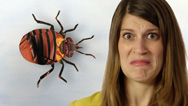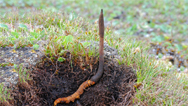Science and Sex Bias
- By Anna Rothschild
- Posted 07.21.16
- NOVA
Science has historically ignored females, whether they're insects, lab rats, or humans. In this episode of Gross Science, find out how sex bias in science has had an impact on everything from medicine to praying mantis research.
Transcript
Science, Sex Bias, and Mantises
Posted: July 21, 2016
This video is about sex bias in science. But to get there, we first need to talk about insect private parts… Like ya do.
I’m Anna and this is Gross Science.
Mantises are tricky to spot because they’re masters of camouflage. But for mantis researchers, finding them is only the beginning. How do you distinguish one species from another, especially when they look so similar? Usually, by looking at their penises.
Well… sort of. Male mantises don’t exactly have penises. They have these: a series of structures that help the male link up, hold on, and pass sperm to the ladies. And the shapes of these structures help researchers tell hundreds of otherwise similar species apart.
Now, this strategy makes some sense: male mantis parts do tend to be pretty conspicuous. But what about female mantises? Because of the focus on male genitalia, it’s difficult to determine what species a lady mantis belongs to. But, for the first time, researchers decided to see if female genitalia could be used to tell praying mantis species apart. And what they found so far is that female genitals are indeed pretty different between groups.
In fact, by examining mantis lady parts, scientists just identified a whole new species. They described this praying mantis using the female’s unique genitals along with more traditional characterics, like where it lives, what it looks like and, yes, the male's genitals, too.
To honor this historic moment in mantis science, researchers named the insect Ilomantis ginsburgae after Ruth Bader Ginsburg, the Supreme Court justice who is a champion for women’s rights. This female-based research approach is one small step towards making our exploration of the tree of life more rigorous.
Unfortunately, sex bias in research has an impact even closer to home. It affects medicine, too. Male lab animals are more often used in research than females because the ladies were thought to confound experiments with their pesky hormonal fluctuations. But while studies in female mice suggest that this concern is totally unfounded, the bias persisted for decades. For example, at least 63% of pharmaceutical drug studies surveyed from 2009 used only male mice. And many scientific studies haven’t even bothered to list the sex of the animals at all.
To fix this problem, the National Institutes of Health have just started requiring researchers to label the sex of their animals and to use females whenever appropriate. But rodents are only half the battle. Until recently, human females were also studied less than their male counterparts in medical research. Some scientists hypothesize that this bias might explain why people with two X chromosomes more often experience adverse effects from medicines than people with an X and Y. It wasn’t until 1993 that the NIH actually required that women and people of color be included as subjects in clinical trials. (And by the way, inequalities in medicine based on race could and should be its own Gross Science video. So stay tuned.)
Anyway, there are many ways in which all humans are the same and require similar care. But where there are differences between people—whether they’re based on sex, or race, or something else—it’s important for us to study rather than ignore them. Otherwise, our medical system won’t be able to adequately care for everyone. And that’s gross.
Ew.
Credits
PRODUCTION CREDITS
- Host, Producer, Animator, Editor
- Anna Rothschild
- Writer, Illustrator, Camera Sound
- Eben E. B. Bein
- Original Footage
- ©WGBH Educational Foundation 2016
- Swing Club E
- Music Provided by APM
IMAGES
- Images of Ilomantis ginsburgae and mantis genitalia
- Courtesy Sydney Brannoch
- U.S. Supreme Court Justices Pose for Group Photo/Ruth Bader Ginsburg
- ©Getty Images/Mark Wilson
- Praying Mantis, Insect, Green
- Pixabay/fill
- Adult female Deroplatys desiccata photographed at Bristol Zoo in 2007
- Wikimedia Commons/Adrian Pingstone
- Choeradodis sp. Hooded Mantis - Cayo District, Belize
- Flickr/Thomas Shahan
- Camouflage: Flower Mantis Hymenopus coronatus on Phalenopsis orchid
- Wikimedia Commons/Philipp Psurek
- Praying Mantis by clearlyambiguous
- Wikimedia Commons/Scott Robinson
- Sphodromantis viridis
- Wikimedia Commons/Mintz_I
SFX
- Cockroaches
-
Freesound/StateAardvark
(used with permission from author) - Squeak Pack/squeak_10
- Freesound/Corsica_S
- Bubbles Popping
- Freesound/ch0cchi
- Insect Trill
- Freesound/metamorphmuses
- Swishes
- Freesound/Pogotron
- Wink
- Freesound/bennychico11
- Royal ping
- Freesound/faston
- Poof of Smoke
- Freesound/planman
- Textmarkerpapier
- Freesound/hannagreen
- Pencil
- Freesound/faston
- Wasserflasche37
- Freesound/schluppipuppie
- Marker Writing on Paper
- Freesound/ftpalad
- Slide whistle down fast 01
- Freesound/joedeshon
- Slide whistle up 01
- Freesound/joedeshon
- Produced by WGBH for PBS Digital Studios
POSTER IMAGE
- U.S. Supreme Court Justices Pose for Group Photo/Ruth Bader Ginsburg
- ©Getty Images/Mark Wilson
- Mantis
- ©WGBH Educational Foundation 2016
Sources
Want more info?
2016 study using female genitalia to identify mantis
species:
http://bit.ly/29ullza/
2011 study surveying the use of male and female animals in
research papers published in 2009:
http://bit.ly/1rsqCv5
2014 study debunking the myth that femal mice are more
variable than male mice:
http://bit.ly/299gCRm
2016 Washington Post piece about Ilomantis ginsburgae:
http://wapo.st/22yfiLf
2015 Nature Neuroscience article on how female mice process
pain differently from male mice:
http://bit.ly/24UbwM1
2015 report on the number of women in clinical trials:
http://1.usa.gov/1GDMLxo
2015 release of the NIH’s new policy to include sex as a
biological variable:
http://1.usa.gov/1PwtvB0
2007 review article on how drugs affect sexes
differently:
http://bit.ly/24UbwM1
2014 news stories on sex bias from NPR, the Boston Globe,
and Nature:
http://n.pr/1PDzVya
http://bit.ly/1S7dtgR
http://go.nature.com/1XrQi90
A 2006 commentary on how sex bias negatively impacts women’s
health:
http://bit.ly/1YuWrjN
Related Links
-

Gross Science
Bizarre stories from the slimy, smelly, creepy world of science.
-

The World’s Priciest Fungus
A fungus that grows from a caterpillar’s head can be worth more than its weight in gold.
-

The Myth of Laziness
The stereotype of the "lazy Southerner" may have been caused by a parasitic infection.
-

I Was a Gross Kid
Gross Science host Anna Rothschild explains why she is so obsessed with gross stuff.

